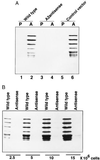Loss of virulence in Leishmania donovani deficient in an amastigote-specific protein, A2
- PMID: 9238059
- PMCID: PMC23140
- DOI: 10.1073/pnas.94.16.8807
Loss of virulence in Leishmania donovani deficient in an amastigote-specific protein, A2
Abstract
Leishmania donovani is the etiologic agent of fatal visceral leishmaniasis in man. During their life cycle, Leishmania exist as flagellated promastigotes within the sandfly vector and as nonflagellated amastigotes in the macrophage phagolysosomal compartment of the mammalian host. The transformation from promastigotes to amastigotes is a critical step for the establishment of infection, and the molecular basis for this transformation is poorly understood. To define the molecular basis for amastigote survival in the mammalian host, we previously identified an amastigote stage-specific gene family termed "A2." In the present study, we have inhibited the expression of A2 mRNA and A2 protein in amastigotes using antisense RNA and show that the resulting A2-deficient amastigotes are severely compromised with respect to virulence in mice. Amastigotes that did survive in the mice had restored A2 protein expression. These data demonstrate that A2 protein is required for L. donovani survival in a mammalian host, and this represents the first identified amastigote-specific virulence factor identified in Leishmania. This study also reveals that it is possible to study gene function in Leishmania through the expression of antisense RNA.
Figures




References
-
- Molyneux D, Killick-Kendrick R. In: The Leishmaniases in Biology and Medicine. Peters W, Killick-Kendrick R, editors. Vol. 1. London: Academic; 1987. pp. 121–176.
-
- Schlein Y. Parasitol Today. 1993;9:255–258. - PubMed
-
- Charest H, Zhang W-W, Matlashewski G. J Biol Chem. 1996;271:17081–17090. - PubMed
-
- Zhang W-W, Charest H, Ghedin E, Matlashewski G. Mol Biochem Parasitol. 1996;78:79–90. - PubMed
Publication types
MeSH terms
Substances
LinkOut - more resources
Full Text Sources
Other Literature Sources

